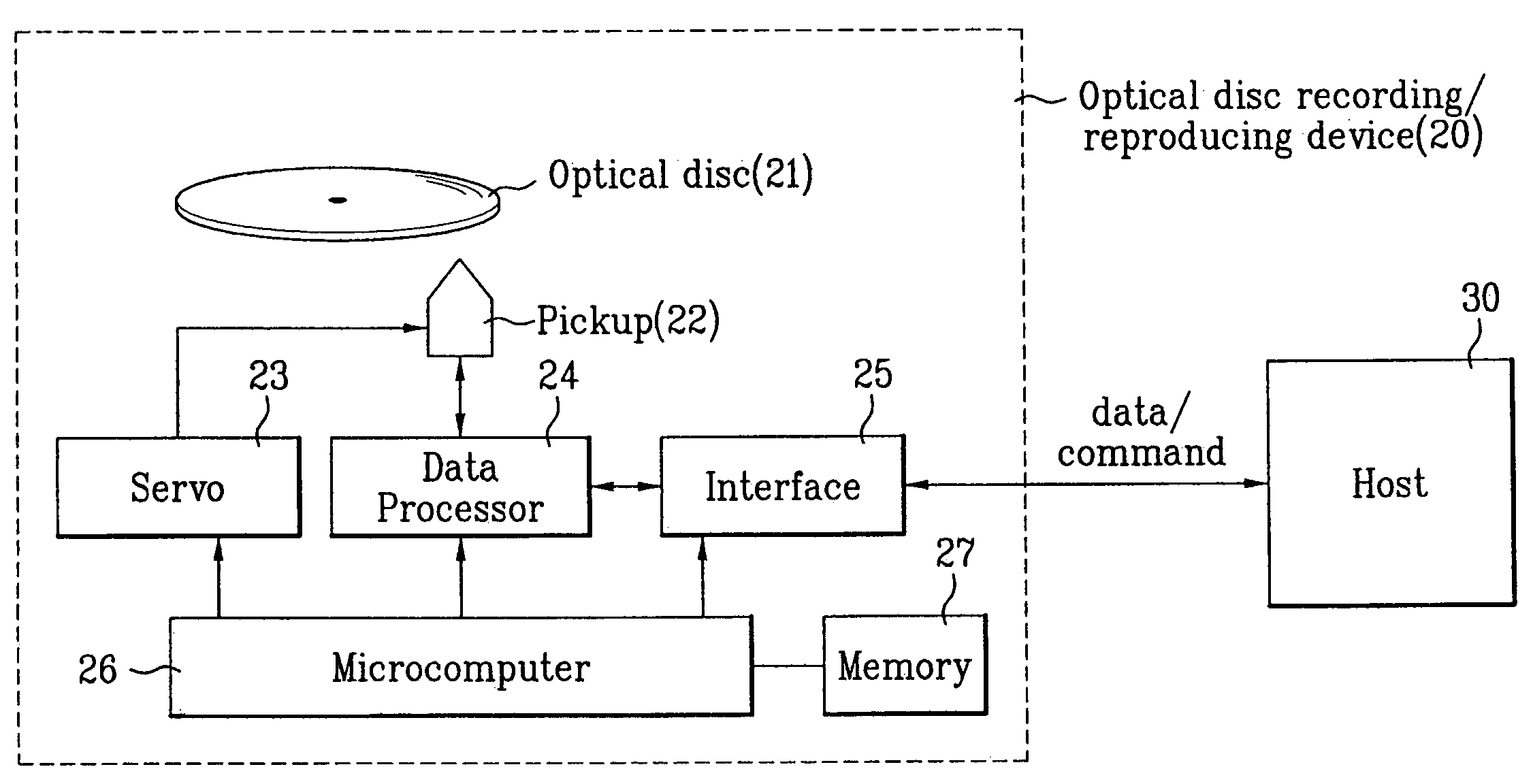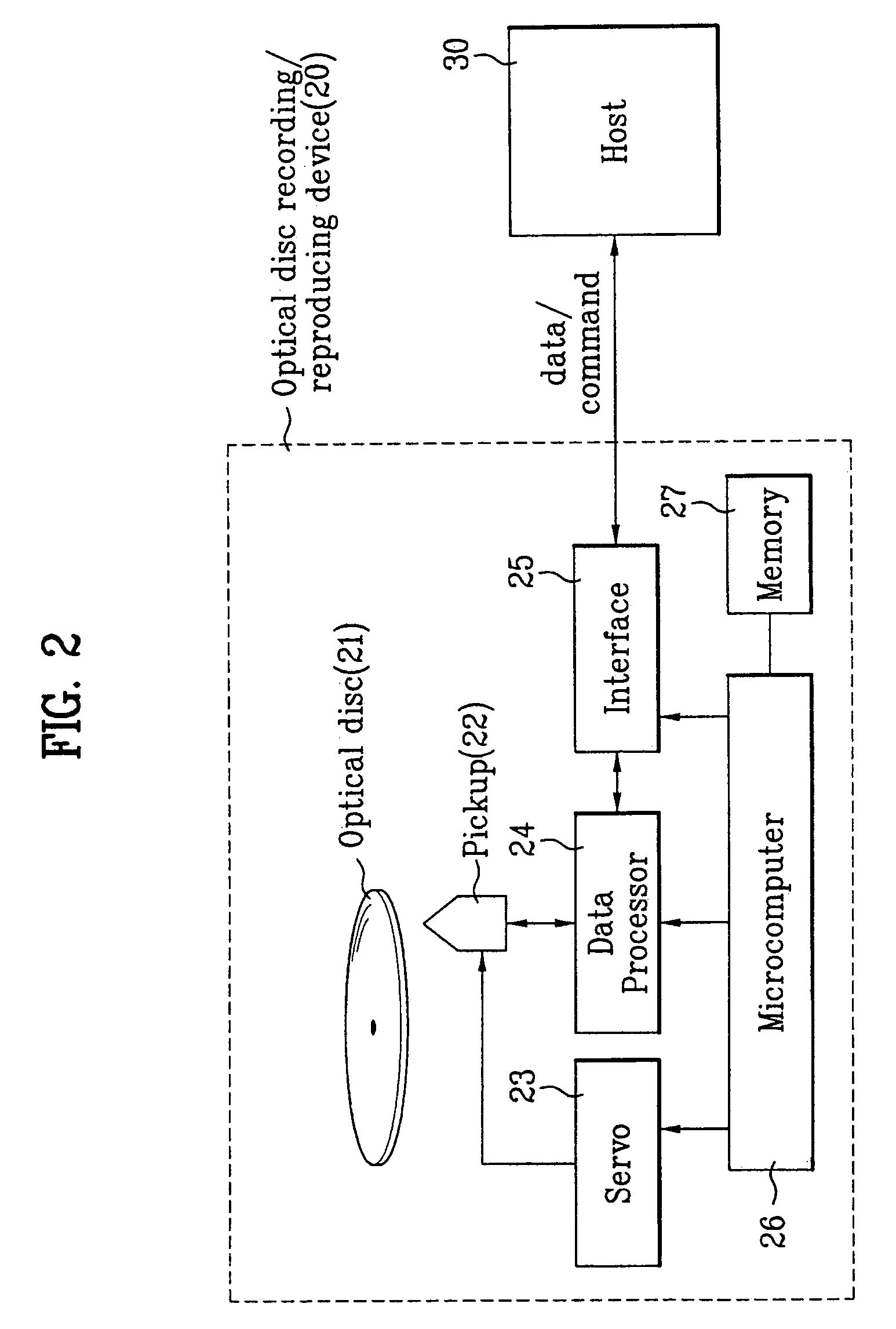Optical disc of write once type, method, and apparatus for managing defect information on the optical disc
a type and optical disc technology, applied in the field of write once optical disc, can solve the problems of large restriction of recording mode and difficulty in randomly using the whole area of the dis
- Summary
- Abstract
- Description
- Claims
- Application Information
AI Technical Summary
Benefits of technology
Problems solved by technology
Method used
Image
Examples
first embodiment
[0059]In summary, according to the method of managing defect information on an optical disc of write once type according to the present invention, the TDFL is cumulatively recorded in the recording unit of a single cluster whenever it is updated. The TDDS then expresses the position of the latest defect management information (TDFL) with one pointer only. Also, in the case that the defect management information is changed according to a sorting rule, it can adaptively cope with such a change.
[0060]In FIG. 6A, the TDFL header has the information that indicates the number of clusters currently used. This means that a flag for representing how many clusters are used for representing the defect management area list can be employed since the size of the defect management information is variable. It is also possible to record the information for representing the number of clusters currently used in not only the TDFL header, but also the TDDS.
[0061]FIG. 6B shows a table that represents the...
second embodiment
[0063]In the second embodiment, one TDFL pointer is used for the corresponding cluster with respect to the TDFL size that increases by stages. Accordingly, even if a defect is identified during the recording of the cluster indicated by TDFL pointer P3 at the second stage (stage2), the defect is overcome through re-recording of only the cluster corresponding to that defect, i.e., the cluster including or beginning with TDFL22. The pointer can be changed to point to the re-recorded area. If it is re-recorded, the defect can be overcome through the change of only the pointer indicated by P3. Thus, the TDMA required for the preparation of the TDFL can be reduced.
[0064]FIG. 7B shows a table that represents the change of the pointer of the TDFL as the TDFL is updated by stages according to the second embodiment of the present invention. In the second embodiment, eight pointers may be required at maximum, and pointers that were not used at the respective stages are set to zero. In this exa...
third embodiment
[0074]In summary, according to the method of managing defect information on an optical disc of write once type according to the present invention, the TDFL header and the TDFL are recorded in the recording unit of a single cluster whenever the TDFL is updated. If the TDDS expresses the position of the latest defect management information, and the recording is performed in excess of a single cluster, repeated recordings are minimized using the information that represents the position of the latest defect management information, and the latest defect management information can be efficiently and promptly obtained.
[0075]Meanwhile, in FIG. 8A, the defect management information may be obtained when the corresponding header has information with respect to the corresponding TDFL contents. Alternatively, the defect management information may be obtained when the latest TDFL header includes all of the TDFL information. For example, at the second stage (stage2), the TDFL header 2 only has inf...
PUM
| Property | Measurement | Unit |
|---|---|---|
| wavelength | aaaaa | aaaaa |
| wavelength | aaaaa | aaaaa |
| thickness | aaaaa | aaaaa |
Abstract
Description
Claims
Application Information
 Login to View More
Login to View More - R&D
- Intellectual Property
- Life Sciences
- Materials
- Tech Scout
- Unparalleled Data Quality
- Higher Quality Content
- 60% Fewer Hallucinations
Browse by: Latest US Patents, China's latest patents, Technical Efficacy Thesaurus, Application Domain, Technology Topic, Popular Technical Reports.
© 2025 PatSnap. All rights reserved.Legal|Privacy policy|Modern Slavery Act Transparency Statement|Sitemap|About US| Contact US: help@patsnap.com



